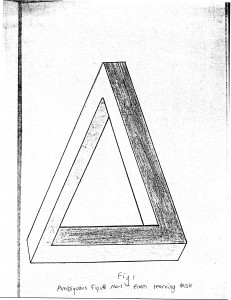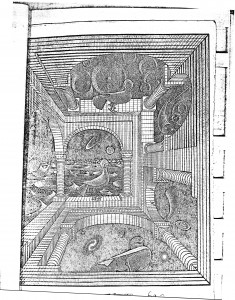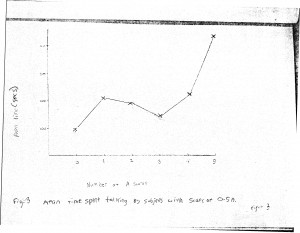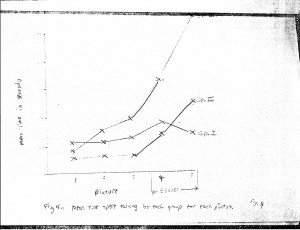Effects of a Learning Task and of Forewarning Upon Responses to Ambiguous Figures (1975)
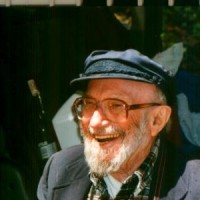
©1975, 2013 by Dallas Denny
Source: Denny, Dallas. (1975). Effects of a learning task and of forewarning upon responses to ambiguous figures. Paper for W.S. Verplanck, University of Tennessee.
Thumbnail Photo: The late W.S. Verplanck, Jr.
This was my first-ever research paper. And yes, it shows.
Effects of a Learning Task and of Forewarning Upon Rsponses to Ambiguous Figures
By Dallas Denny
For Dr. W.S. Verplanck
University of Tennessee
Abstract
Abstract
It is probable people experience reality in different ways. Some people experience their environment more thoroughly than others. People can be manipulated to experience their environments in different ways than they would have without manipulation. It was decided to test the effectiveness of a learning task in viewing ambiguous pictures. Five ambiguous prints (two by M. C. Escher and three simple geometric figures) were selected and placed in a loose leaf notebook. Two groups (II and III) viewed the pictures in the aforementioned order. Group III received a forewarning before starting the task. Group II served as a control for Groups I and III. Group I viewed the pictures in reverse order, with the simple figures comprising a learning task. All subjects were scored for ambiguity. Results indicated that scores of A (ambiguity) tended to be followed by A scores and N (no ambiguity) scores tended to be followed by N scores for both groups I and III and for combined groups. Group I received significantly fewer A scores and Group III received significantly more A scores than did the control group. Across groups, persons who received all A scores tended to spend more time looking at and talking about pictures than did subjects who received all N scores. It was concluded that forewarning was effective in eliciting A responses. The learning task is quite suspect and may have served to train subjects not to emit A responses.
Interplay of each person’s past experiences and genetic makeup make him/her a unique individual who experiences his/her environment in a unique way. Phenomenologists hold that reality exists only as experienced by the individual. “Reality” thus varies over individuals. It is possible to some extent to manipulate others so they experience their surroundings differently than they would had they not been so manipulated (Schacter & Wheeler, 1962). So it is indicated that it is possible to change awareness of one’s environment. There seem to be other methods which also change this awareness: learning, various physiological states such as sickness, level of alertness, drug states, meditational states, hyperventilational states, etc. (Tart, 1975, Chs. 1, 22, 27).
Since individuals evidence a qualitative difference in experiencing their environments, it seems reasonable to hypothesize a quantitative difference. Some persons may experience their environment more thoroughly than others. An area where such quantitative differences might be expected to show up is art. But since artistic taste is a highly subjective matter, it was decided to concentrate upon ambiguous pictures for the purposes of this experiment.
The Flemish artist Maurits Cornelius Escher (1898-1972) created many woodcuts and lithographs which contain ambiguities (Teuber, 1964). His early works centered mostly around figure-ground ambiguity, but much of his later work involved changes in perspective.
A pilot study involving many of Escher’s prints indicated that most persons would see these ambiguities; especially after having two or three ambiguities pointed out to them, subjects were quick to spot others. Since all subjects in the pilot study (n=11) could eventually spot ambiguities easily, two of Escher’s prints containing ambiguity of perspective were chosen for use in later experiments.
It was decided to manipulate subjects in two ways: 1) to forewarn them the pictures were tricky and 2) to provide a learning task in an attempt to cause the subjects to respond to the ambiguity in Escher’s prints.
Method
Materials
Materials consisted of five ambiguous figures, an instruction sheet, a warning page, and a loose leaf notebook. Interviews were recorded on a portable cassette-type tape recorder, with Ss permission. The ambiguous figures were drawn or printed upon white unlined paper which was cemented to white poster board of the same size (23×23 cm) and placed in the notebook along with the instruction sheet, and, in the case of one experimental group, the warning page. Another page, containing three questions, appeared as the last page for all groups (see Appendix A). The order of the figures in the notebook could be changed quickly and easily by the experimenter.
Three of the ambiguous figures were simple geometric forms of a type often encountered in introductory psychology textbooks (see Fig. 1). These three figures, designated numbers one, two, and three in the data analysis, served as a learning task. The remaining two figures were a lithograph and a wood engraving by Escher (1960, see Fig. 2). Captions of these two figures were covered with opaque tape so subjects could get no cues from the picture titles. The figures were designated numbers four and five in the analysis.
The instruction sheet was placed in the notebook in such a way that subjects saw it immediately upon opening the notebook.
Subjects
Subjects were friends and family of the experimenter. This method of subject selection was chosen because 1) Ss represented both sexes and had a wide range of educational levels, interests, lifestyles, incomes, occupations, and ages; and 2) Ss were readily available and were at ease with the experimenter. Ss ranged in age from early teens to mid-fifties. There was a total of twenty-seven Ss, of which fourteen were females.
Procedure
Ss were divided into three groups. Group I was given the notebook with the pictures in numerical order (the learning task preceding the Escher prints). Group III was shown the pictures in reverse numerical order with the warning sheet, on which was printed “Watch these. They’re tricky!” immediately following the instruction sheet (for groups I and II this sheet was omitted). Group II was also shown the figures in reverse numerical order; in this manner the second group served as a control for the other two two groups.
- n for Group I was 1
- n for Group II was 8
- n for Group III was 6
The experiment was conducted in the homes of the subjects, with the tape recorder in plain view. Subjects were told only that they were participating in an experiment which was concerned with how people saw things. Instructions were read orally by the experimenter to each subject as many times as were necessary. Subjects were told they must look at the pictures in order, not turning back to look at earlier pictures until they signaled completion of the last picture, but that they might take as long as they wished to look at each picture. They wore also told the experimenter would remain silent during the task.
Results
Since it was impossible to assess exactly what each subject “saw,” responses were rated A (ambiguity) or N (no ambiguity) On the basis of recorded responses. If a subject spoke of ambiguity either directly or indirectly he or she was assigned an A score for that figure. If the subject did not speak of ambiguity, she received an N. This method of analysis is conservative in measuring ambiguity; if a subject did not speak of ambiguity when observing a figure, whether he saw ambiguity or not, he received a score of N for that figure.
It was noted that eight of the subjects received no A scores. Six of these eight were in Group I. Since it is statistically significant (p < .05) that six of these eight subjects were in Group I, the learning task is quite suspect and may have served to train subjects not to provide A responses. Group I, as a whole, received fewer A scores than either of the other two groups.
Five subjects received an A score for all figures. Four of these were in Group III. Since this is significant (p<.05) and since it is also significant (p<.05, Mann-Whitney U test) that Group III received a larger percentage of A scores than did the control group, it was concluded that forewarning was effective in eliciting A responses.
Data were tabulated in the following manner: scores of N or A immediately followed by N; of N immediately followed by A; of A immediately followed by N; and by A immediately followed by A were tabulated. Separately considered, both Groups I and II were significantly (p<.001) different from a chance distribution, whereas the control group was not. Both groups differed significantly(p<.001) from the control group. It was concluded that both forewarning and the learning task caused subjects to tend to follow A responses with A responses and N responses with N responses.
Total time talking about each figure was measured. Subjects were divided into groups according to how many A scores they received and their mean times plotted (Fig. 2). Subjects who received no A scores spent least time talking; subjects who received all A scores spent a much greater time talking (and looking) than did any of the other subjects,
Figure 4 shows mean times spent talking by each group for each picture. Group II does not differ from the control group in this respect; it must be concluded that the learning task did not cause subjects to spend more time looking at and talking about the pictures. Group III, however, spent considerably more time on the Escher pictures (which they saw before the learning task), indicating that forewarning did have an effect upon the time spent looking at the pictures. Most subjects spent more time looking at the pictures than they looking at the pictures in the learning task.
Only a few of the subjects thought that they had ever before seen any pictures by M. Escher, and none of them knew his name. More than half of the subjects said the pictures made them feel “strange” or “weird.” Subjects either liked or disliked the pictures; there were no noncommittal answers when they were asked whether they liked the pictures.
Discussion
That forewarning is an effective way of alerting people can best be verified by examining its long history. The alerted person is quicker to respond to all sorts of situations than the nonalerted person. This seems to hold true over a number of situations, from looking out for snakes to looking out for ambiguity. It seems forewarning lets the person know something is going on sooner than he or she might have noticed had be not been forewarned. A member of Group I commented to the experimenter that he would have said more about the ambiguities if he had only known to.
When looked at on the basis of numbers of ambiguities mentioned, the specific learning task used in this study was ineffectual and perhaps even detrimental to the mentioning of ambiguity. This, or course, is not to say that all learning tasks are ineffective. When coupled with forewarning, especially, learning tasks may be very effective.
Figure Captions
Figure 1: Ambiguous figure number one— from learning task
Figure 2: Ambiguous figure number four— by Escher
Figure 3: Mean time spent talking by subjects with scores of 0-5 A
Figure 4: Mean time spent talking by each group for each picture
Appendix A
1. Do you think you have ever before seen any pictures by the artist who drew the first (last) two pictures? Do you know his name?
2. How did these pictures make you feel?
3. Did you like them?
Bibliography
Attneave, Fred. 1968. Triangles as ambiguous figures. American Journal of Psychology, 81(3), 447-453.
Boring, E.G. (1953). A history of introspection. Psychological Bulletin, 5(1), 169-189.
Escher, M.C. (1971). The World of M. C. Escher. New York: Harry N. Abrams, Inc.
Escher, M.C. (1960). The graphic work of M. C. Escher. New York: Ballantine Books, Inc.
Fisher, Gerald H. (1967). Ambiguous figure treatments in the art of Salvador Dali. Perception and Psychophysics, 2(8), 328-30.
Froman, Robert. (1970). Science, art and visual illusion. New York: Simon & Schuster.
Hays, W. L. (1973). Statistics for the social sciences. New York: Holt, Rinehart, & Winston.
James, William. (1890). Principles of psychology. New York: Henry Holt & Co.
Morgan, Clifford T. and R. A. King. (1966). Introduction to psychology. New York: McGraw-Hill.
Schacter, & L. Wheeler. (1962). Epinephrine, chhlorpromiazine, & amusement. J. of Abnormal and Social Psychology, 45 121-128.
Siegel, S. (1956). Nonparametric statistics for the behavioral sciences. New York: McGraw-Hill.
Tart, C. (1975). States of consciousness. Plume.

